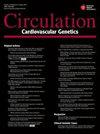缺血性人左心室的长非编码RNA景观
Q Medicine
引用次数: 22
摘要
背景——长非编码RNA(lncRNA)功能类的发现扩大了我们对细胞中存在的各种RNA物种的理解。在心脏中,lncRNA与发育、缺血性和扩张型心肌病以及心肌梗死的调节有关。然而,对这些转录物在人类受试者中的表达谱的描述有限。方法和结果——我们从接受心脏手术的人类患者身上获得了左心室组织,并使用RNA测序来描述lncRNA图谱。然后,我们确定了体外循环缺血损伤前后成对样本之间差异表达的lncRNA列表。其中一些lncRNA的表达与缺血时间相关。与差异表达的lncRNA非常接近的编码基因以及与这些lncRNA协调表达的编码基因在与心肌梗死相关的功能类别中富集,包括心脏功能、代谢、应激反应和免疫系统。结论——我们描述了一系列在人类心脏缺血后差异表达的lncRNA。据预测,这些基因在与心肌损伤一致的途径中发挥作用。因此,lncRNA可以作为缺血性心脏病的新的诊断和治疗靶点。临床试验注册--URL:http://www.clinicaltrials.gov.唯一标识符:NCT00985049。本文章由计算机程序翻译,如有差异,请以英文原文为准。
The Long Noncoding RNA Landscape of the Ischemic Human Left Ventricle
Background— The discovery of functional classes of long noncoding RNAs (lncRNAs) has expanded our understanding of the variety of RNA species that exist in cells. In the heart, lncRNAs have been implicated in the regulation of development, ischemic and dilated cardiomyopathy, and myocardial infarction. Nevertheless, there is a limited description of expression profiles for these transcripts in human subjects. Methods and Results— We obtained left ventricular tissue from human patients undergoing cardiac surgery and used RNA sequencing to describe an lncRNA profile. We then identified a list of lncRNAs that were differentially expressed between pairs of samples before and after the ischemic insult of cardiopulmonary bypass. The expression of some of these lncRNAs correlates with ischemic time. Coding genes in close proximity to differentially expressed lncRNAs and coding genes that have coordinated expression with these lncRNAs are enriched in functional categories related to myocardial infarction, including heart function, metabolism, the stress response, and the immune system. Conclusions— We describe a list of lncRNAs that are differentially expressed after ischemia in the human heart. These genes are predicted to function in pathways consistent with myocardial injury. As a result, lncRNAs may serve as novel diagnostic and therapeutic targets for ischemic heart disease. Clinical Trial Registration— URL: http://www.clinicaltrials.gov. Unique identifier: NCT00985049.
求助全文
通过发布文献求助,成功后即可免费获取论文全文。
去求助
来源期刊

Circulation-Cardiovascular Genetics
CARDIAC & CARDIOVASCULAR SYSTEMS-GENETICS & HEREDITY
CiteScore
3.95
自引率
0.00%
发文量
0
期刊介绍:
Circulation: Genomic and Precision Medicine considers all types of original research articles, including studies conducted in human subjects, laboratory animals, in vitro, and in silico. Articles may include investigations of: clinical genetics as applied to the diagnosis and management of monogenic or oligogenic cardiovascular disorders; the molecular basis of complex cardiovascular disorders, including genome-wide association studies, exome and genome sequencing-based association studies, coding variant association studies, genetic linkage studies, epigenomics, transcriptomics, proteomics, metabolomics, and metagenomics; integration of electronic health record data or patient-generated data with any of the aforementioned approaches, including phenome-wide association studies, or with environmental or lifestyle factors; pharmacogenomics; regulation of gene expression; gene therapy and therapeutic genomic editing; systems biology approaches to the diagnosis and management of cardiovascular disorders; novel methods to perform any of the aforementioned studies; and novel applications of precision medicine. Above all, we seek studies with relevance to human cardiovascular biology and disease. Manuscripts are examined by the editorial staff and usually evaluated by expert reviewers assigned by the editors. Both clinical and basic articles will also be subject to statistical review, when appropriate. Provisional or final acceptance is based on originality, scientific content, and topical balance of the journal. Decisions are communicated by email, generally within six weeks. The editors will not discuss a decision about a manuscript over the phone. All rebuttals must be submitted in writing to the editorial office.
 求助内容:
求助内容: 应助结果提醒方式:
应助结果提醒方式:


